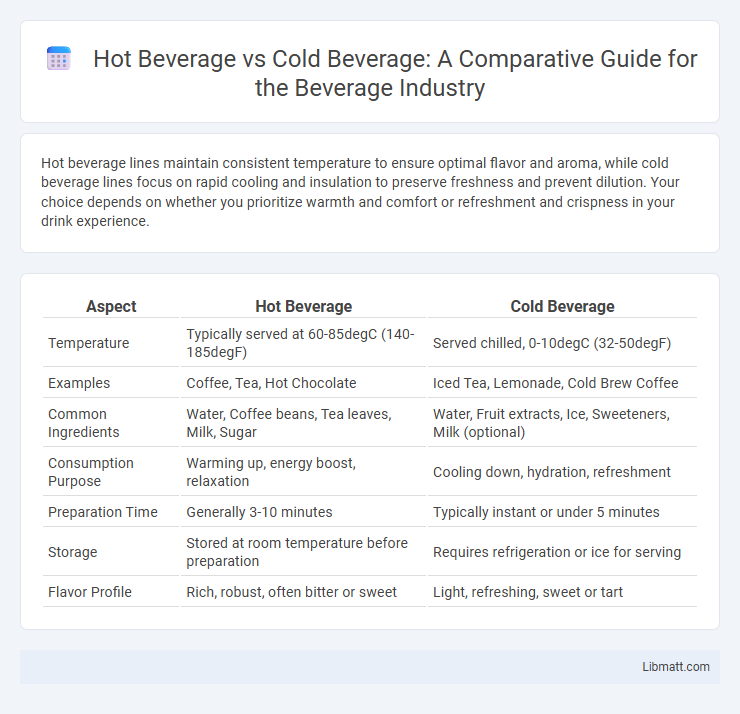Hot beverage lines maintain consistent temperature to ensure optimal flavor and aroma, while cold beverage lines focus on rapid cooling and insulation to preserve freshness and prevent dilution. Your choice depends on whether you prioritize warmth and comfort or refreshment and crispness in your drink experience.
Table of Comparison
| Aspect | Hot Beverage | Cold Beverage |
|---|---|---|
| Temperature | Typically served at 60-85degC (140-185degF) | Served chilled, 0-10degC (32-50degF) |
| Examples | Coffee, Tea, Hot Chocolate | Iced Tea, Lemonade, Cold Brew Coffee |
| Common Ingredients | Water, Coffee beans, Tea leaves, Milk, Sugar | Water, Fruit extracts, Ice, Sweeteners, Milk (optional) |
| Consumption Purpose | Warming up, energy boost, relaxation | Cooling down, hydration, refreshment |
| Preparation Time | Generally 3-10 minutes | Typically instant or under 5 minutes |
| Storage | Stored at room temperature before preparation | Requires refrigeration or ice for serving |
| Flavor Profile | Rich, robust, often bitter or sweet | Light, refreshing, sweet or tart |
Introduction to Hot and Cold Beverage Lines
Hot beverage lines are specialized systems designed to maintain and deliver beverages at elevated temperatures, typically around 160degF to 190degF, ensuring optimal flavor and safety for drinks such as coffee, tea, and hot chocolate. Cold beverage lines operate at chilled temperatures, usually between 32degF and 45degF, to preserve freshness and prevent bacterial growth in drinks like iced tea, lemonade, and soft drinks. Both systems rely on insulated piping, temperature controls, and sanitation protocols tailored to the thermal properties and hygiene standards of hot and cold beverages.
Consumer Preferences: Hot vs. Cold Beverages
Consumer preferences for hot versus cold beverage lines vary significantly based on climate, occasion, and cultural habits, with hot beverages like coffee and tea favored in cooler weather for warmth and comfort. Cold beverages, such as iced tea, smoothies, and sodas, dominate in warmer climates and during physical activities for refreshment and hydration. Market trends indicate a growing demand for innovative flavors and health-conscious options in both categories, reflecting evolving consumer tastes and lifestyle choices.
Key Ingredients in Hot and Cold Beverage Lines
Key ingredients in hot beverage lines often include coffee beans, tea leaves, milk, and spices such as cinnamon or cardamom, which contribute to rich flavors and aromatic profiles. Cold beverage lines typically feature ingredients like ice, fruit juices, carbonated water, and syrups, providing refreshing and vibrant taste experiences. Both lines may incorporate natural sweeteners such as honey or agave to enhance flavor without overpowering the base ingredients.
Market Trends: Hot Beverage Lines
Hot beverage lines continue to dominate the global beverage market, driven by strong consumer demand for specialty coffees, teas, and health-infused drinks. Market trends indicate a surge in premiumization, with consumers seeking artisanal blends, organic ingredients, and sustainable sourcing practices. Your business can capitalize on this growth by integrating innovative brewing technologies and offering customizable hot beverage options that cater to evolving taste preferences.
Market Trends: Cold Beverage Lines
Cold beverage lines dominate the market with a growing consumer preference for refreshing and health-conscious drinks such as iced teas, cold brews, and flavored waters. Advances in packaging technologies and innovative product formulations, including low-calorie and functional beverages, drive increased demand across retail and foodservice sectors. Market data indicates a significant growth rate in cold beverage sales globally, fueled by rising urbanization and changing lifestyle habits favoring convenience and on-the-go consumption.
Health Benefits: Hot vs. Cold Beverages
Hot beverages like herbal teas can aid digestion and improve circulation, while cold beverages such as iced water help with hydration and cooling the body. Consuming hot drinks may enhance relaxation and relieve congestion, whereas cold drinks can reduce inflammation and provide quick refreshment. Your choice between hot and cold beverages depends on the desired health benefits and the climate you're in.
Packaging Innovations for Hot and Cold Beverage Lines
Innovations in packaging for hot and cold beverage lines are transforming consumer convenience and product safety, with thermal-insulated containers and splash-proof lids designed to maintain optimal temperatures and prevent spills. Sustainable materials such as biodegradable plastics and recyclable aluminum are increasingly used to reduce environmental impact while enhancing durability and functionality. Your beverage packaging now combines technology and eco-friendly design, ensuring freshness and a premium experience for every sip.
Seasonal Demand: Hot and Cold Beverage Sales
Hot beverage sales peak during colder months due to increased demand for warmth and comfort, while cold beverage sales surge in warmer seasons as consumers seek refreshment. Understanding the seasonal demand patterns helps optimize inventory and marketing strategies for hot and cold beverage lines. Your business can maximize profits by aligning product availability with these fluctuating consumer preferences.
Sustainability Concerns in Beverage Production
Hot beverage production often demands higher energy consumption due to steaming and brewing processes, increasing its environmental footprint compared to cold beverage lines that can leverage chilled water systems more efficiently. Cold beverages typically require significant refrigeration, contributing to greenhouse gas emissions, but innovations in sustainable cooling technologies are mitigating these impacts. Your choice between hot and cold beverage lines should consider not only consumer preferences but also the sustainability initiatives integrated into production methods.
Future Outlook for Beverage Industry: Hot vs. Cold Lines
The future outlook for the beverage industry indicates strong growth in both hot and cold beverage lines, driven by evolving consumer preferences and technological advancements. Hot beverage lines are expected to expand with innovations in specialty coffee and tea, emphasizing sustainability and health benefits, while cold beverage lines will witness increased demand for functional drinks, such as flavored waters and plant-based options. Market forecasts predict the overall beverage sector to grow at a CAGR of over 5%, with significant investments in automated production lines to meet diverse consumer needs efficiently.
Hot beverage vs cold beverage lines Infographic

 libmatt.com
libmatt.com